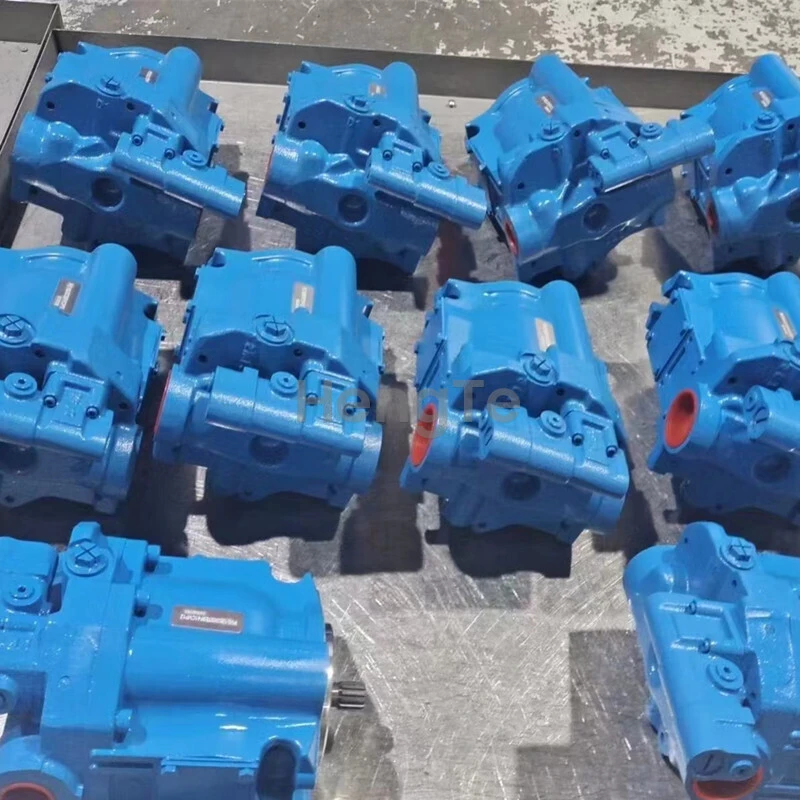Water Ethylene Glycol Plunger Pump Steel Factory Special Hydraulic Pump Parker PAVC100R4222 Piston Pump
Structural principle of Parker plunger pump
HENGTE Company produces and manufactures a complete replacement for Parker plunger pumps. The characteristics of water glycol determine that a specialized water glycol hydraulic plunger pump must be used to ensure the normal operation of the system. Ordinary hydraulic pumps cannot be used for water glycol, and even if reluctantly used, the pump's lifespan is very short. Therefore, Pelex has professionally developed and manufactured the PPAVC100 series plunger pump using water ethylene glycol hydraulic medium, providing protection for hydraulic equipment in special industry applications such as metallurgy, steel mills, power plants, and casting.
Parker Pavc100 Water Glycol Hydraulic Plunger Pump Water Glycol is a transparent solution with a water content of 35% -55% formed by dissolving ethylene glycol, propylene glycol, or their polymers in water. It also includes corresponding additives such as viscosity increasing, wear resistance, rust prevention, and defoaming. It has good flame resistance, low-temperature fluidity, and stability, making it an ideal flame resistant hydraulic medium. It has been widely used in hydraulic systems that require fire protection in metallurgy, mining, and casting and forging, and has become the mainstream of flame resistant hydraulic fluids in many countries.
Water ethylene glycol hydraulic fluid is widely used in hydraulic equipment systems such as die-casting, rolling mills, continuous casting machines, coke blocking machines, glass forming machines, and converter synthesis gas in industries such as metallurgy, power, machinery, and chemical engineering.
Operating Procedures for Water Ethylene Glycol Fire-resistant Hydraulic Fluid
1. Firstly, thoroughly drain the residual oil from the PAVC100 hydraulic pump system dedicated to the steel plant to remove oil stains and deposits.
2. Inject water ethylene glycol fire-resistant hydraulic fluid according to the required amount of PAVC100 hydraulic pump for circulation in the steel plant, and then run for 8-48 hours.
3. After 8-48 hours, it is not allowed to stand still after stopping the pump. Immediately drain the flushing fluid from the oil tank.
4. After adding a sufficient amount of this product, the hydraulic system will officially run.
5. After working for a week, stop the hydraulic pump in the steel plant and check the oil floating in the oil tank. The allowable residual oil floating in the hydraulic system is less than 3%.
Common models of PV series plunger pumps:
Parker high-pressure oil pump PV016R1K1T1N;
Parker high-pressure oil pump PV023R1K1T1N;
Parker high-pressure oil pump PV032R1K1T1N;
Parker high-pressure oil pump PV040R1K1T1N;
Parker high-pressure oil pump PV046R1K1T1N;
Parker high-pressure oil pump PV063R1K1T1N;
Parker high-pressure oil pump PV080R1K1T1N;
Parker high-pressure oil pump PV092R1K1T1N;
Parker high-pressure oil pump PV140R1K1T1N;
Parker high-pressure oil pump PV180R1K1T1N;
Parker high-pressure oil pump PV270R1K1T1N;
Parker high-pressure oil pump PV016R1K1T1NMR1;
Parker high-pressure oil pump PV046R1K1KJNMRW;
Parker high-pressure oil pump PV046R1K1S1NFWS;
Parker high-pressure oil pump PV092R1D1T1NMMC;
Parker high-pressure oil pump PV092RK1T1NMMC;
Parker high-pressure oil pump PV140R1K1T1N001;
Parker high-pressure oil pump PV140R1K1T1NFWS;
Parker high-pressure oil pump PV140R1K4T1VMMW-MOD (M14);
Parker high-pressure oil pump PV180R1K1T1WFWS;
Parker high-pressure oil pump PV180R1K1T1NMMC;
Parker high-pressure oil pump PV180R1K1T1NULC;
Parker high-pressure oil pump PV180R1K8S1NFWS;




















